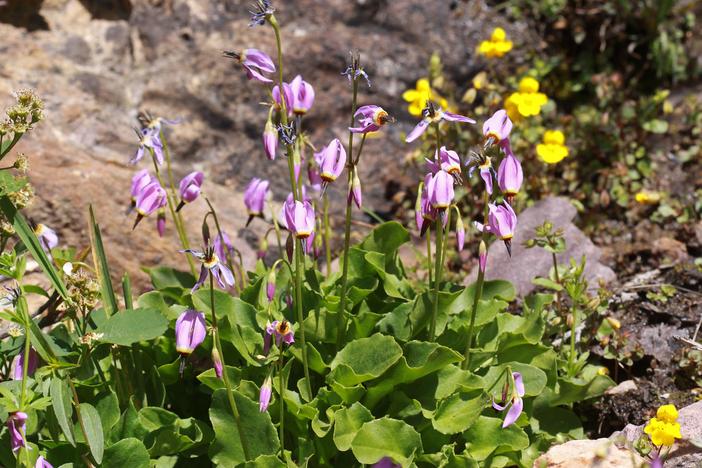White Shootingstar
(Dodecatheon dentatum)
White Shootingstar (Dodecatheon dentatum)
/
/

Andrey Zharkikh
CC BY 2.0
Image By:
Andrey Zharkikh
Recorded By:
Copyright:
CC BY 2.0
Copyright Notice:
Photo by: Andrey Zharkikh | License Type: CC BY 2.0 | License URL: https://creativecommons.org/licenses/by/2.0/ | Uploader: AndreyZharkikh | Publisher: Flickr


























Estimated Native Range
Summary
Dodecatheon dentatum, commonly known as White Shootingstar, is a deciduous perennial herb native to moist meadows, streambanks, and forest understories in the Pacific Northwest of North America. It typically grows to a height of 1-2 feet and a width of 0.3 feet. The plant features basal rosettes of oblong leaves and erect flowering stems that bear clusters of distinctive white to cream, reflexed flowers resembling a falling star, which bloom in the spring. The flowers are particularly showy due to their unique shape and the contrasting yellow and maroon markings on their petals and stamens.
White Shootingstar is valued for its striking spring flowers and is often used in native plant gardens, woodland gardens, and shaded border plantings. It is of special value to native bumblebees, which are key pollinators. While it prefers consistently moist soils, it is relatively low maintenance once established. After flowering, the plant typically goes dormant, disappearing until the next spring. It has earned the Royal Horticultural Society’s Award of Garden Merit, indicating its exceptional qualities as a garden plant. Cultivation requires attention to mimic its natural moist and well-drained soil conditions, and it thrives in full sun to part shade.CC BY-SA 4.0
White Shootingstar is valued for its striking spring flowers and is often used in native plant gardens, woodland gardens, and shaded border plantings. It is of special value to native bumblebees, which are key pollinators. While it prefers consistently moist soils, it is relatively low maintenance once established. After flowering, the plant typically goes dormant, disappearing until the next spring. It has earned the Royal Horticultural Society’s Award of Garden Merit, indicating its exceptional qualities as a garden plant. Cultivation requires attention to mimic its natural moist and well-drained soil conditions, and it thrives in full sun to part shade.CC BY-SA 4.0
Plant Description
- Plant Type: Herb
- Height: 1.2-1.8 feet
- Width: 0.2-0.3 feet
- Growth Rate: Moderate
- Flower Color: White, Cream
- Flowering Season: Spring
- Leaf Retention: Deciduous
Growth Requirements
- Sun: Full Sun, Part Shade
- Water: Medium
- Drainage: Fast
Common Uses
Bee Garden, Butterfly Garden, Deer Resistant, Fragrant, Low Maintenance, Rock Garden
Natural Habitat
Moist meadows, streambanks, and forest understories in the Pacific Northwest
Other Names
Common Names: Toothed American Cowslip
Scientific Names: , Dodecatheon dentatum, Primula standleyana, Dodecatheon ellisii, Dodecatheon frigidum var. dentatum, Meadia dentata,
GBIF Accepted Name: Dodecatheon dentatum Hook.